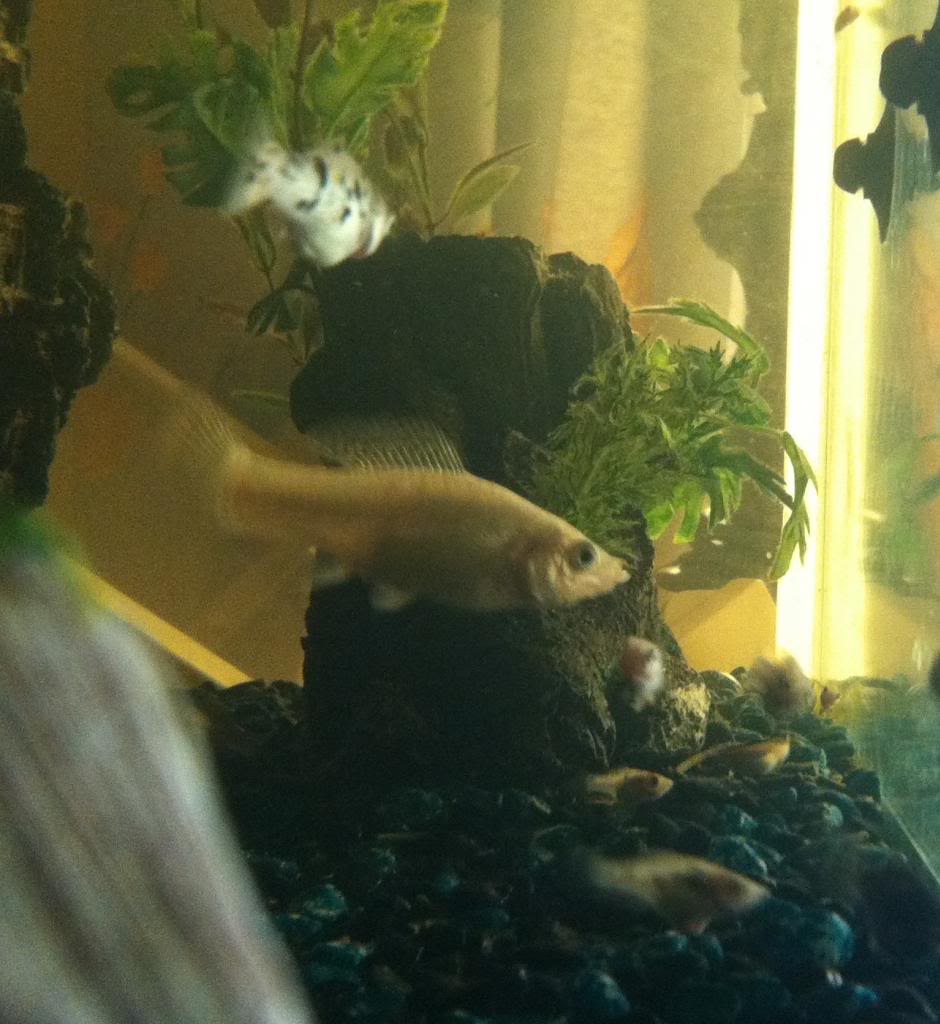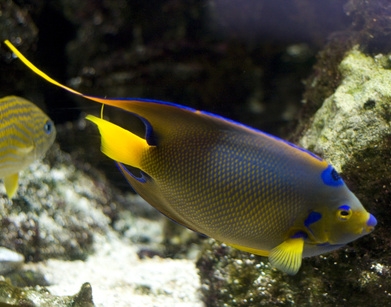

Freshwater angelfish (scientific name: Pterophyllum scarlare) are a popular aquarium fish species, and for good reason. They are attractive and easily make an eye catching addition to any community tank. They are also easy to breed. Whether you were planning to try angelfish breeding or not, you may one day discover that your angelfish are a breeding pair with the appearance of hundreds of eggs. Here are some angelfish breeding tips on helping your angelfish care for those unexpected eggs.
Basic Freshwater Angelfish Care
First you need to learn about angelfish care and basic needs. Having healthy parents will make it more likely that you have some eggs that hatch and survive. Angelfish are omnivores and eat most anything. It's best to feed them a variety of processed fish food, frozen fish food, and live foods such as brine shrimp reports author Joseph S. Levine in The Complete Fishkeeper
 . They will also eat fresh vegetables or your live aquarium plants. Water temperatures should be kept at about 75 to 85 degrees F and pH should 6.7 to 7.5. These are large fish as adults and do need a large tank, at least 30 gallons for two. For these tall fish, a tall tank rather than a long tank is better.
. They will also eat fresh vegetables or your live aquarium plants. Water temperatures should be kept at about 75 to 85 degrees F and pH should 6.7 to 7.5. These are large fish as adults and do need a large tank, at least 30 gallons for two. For these tall fish, a tall tank rather than a long tank is better.
Telling Male Angelfish from Female Angelfish
Unfortunately, you may not truly know if you have a breeding male and female pair of angelfish or experienced angelfish breeders until the fry hatch, as the males and females can be difficult to tell apart. Some things to look for are physical and behavior characteristics, but keep in mind that these are not foolproof. Sometimes females take on male behaviors and characteristics. Males have a small bump on the nose and develop a more pointed papilla near the anal fin for fertilizing the eggs. Males may be more territorial in protecting their female and nest. After the female lays the eggs, the male will pass over the eggs fertilizing them. This may continue for several minutes to several hours.
About Angelfish Eggs
The angelfish eggs will be laid on a large flat surface such as a leaf that was cleaned by the male prior to egg laying. The parents may vigilantly care for them by standing guard and even move the eggs around. Where they move their eggs to may surprise you. You may discover eggs stuck to the wall of the tank or even the filter. Inexperienced parents may just eat the eggs and your angelfish breeding days are done for now. The parents may be more successful with the next batch. Angelfish can spawn every two to four weeks.
Take a close look at the eggs to determine if they are fertile. Dead or unfertilized eggs will be a solid white color. Clear or slightly yellow eggs that you can see into are fertile. With clear fertile eggs you should start seeing the fry wiggling within 48 hours. If you don't then the eggs have died, possibility because of a bacterial or fungal infection. The eggs will hatch 6 to 7 days after being laid.
About Angelfish Egg and Fry Care
Once you've discovered the eggs, how much you choose to participate in the care of the fry depends largely on how many angelfish babies you want to see survive and are able to care for.
Option 1 – Leave Them Be: In a community tank with inexperienced angelfish breeders, you are not likely to see any fry survive. Some parents will eat the eggs and any hatched fry. If the parents do not sufficiently protect the eggs, then other tank members will eat the eggs and fry. Also, gravel and tank filters where eggs and fry can get stuck are serious hazards and will limit how many fry survive.
However, if this is not the first batch of eggs laid by your angelfish, they may have learned some parenting skills and take good care of the eggs. If your community tank is well planted with lots of hiding places for the fry, then you may have a couple angelfish babies survive into adulthood. Many hobbyists believe that allowing the parents to raise the fry is best. This allows for the strongest to survive and hopefully pass on good parenting genes.
Option 2: Move the Eggs to a Hatching Tank: You can set up a small tank to raise the fry in. Then move the nest to that tank for hatching and fry care. If you want to get into serious angelfish breeding, put a flat slate into the tank for the fish to lay the eggs on. This will be easier to move to a hatching tank once the eggs are laid.
Feeding Angelfish Fry
The best food for the fry is just hatched brine shrimp fed several times a day. Other food options that you can try include Liquifry and Micro-feed. Your local aquarium store can help you choose a food for the baby angelfish. If you have left the fry with the parents then you may also notice the babies biting at the parents. "After hatching the fry feed on body mucus ("milk") secreted by the parents," reports 500 Freshwater Aquarium Fish
These tips are for the accidental angelfish breeder. However, the process may get you hooked. If you are interested in becoming a more successful freshwater angelfish breeder then you will need to learn more about the different specific methods that other angelfish breeders have developed and found success with. Your local aquarium store can help connect you with local fish breeders to learn from. Reading books by experts and joining forum discussion will also help you learn successful freshwater angelfish breeding techniques. However, much of learning to breed fish comes from trial and error and learning what works best with your aquariums and fish.
 Breeding Tropical Fish
Credit: Alana R
Breeding Tropical Fish
Credit: Alana R
 How to Take Care of The Baby Betta Fish
How to Take Care of The Baby Betta Fish
How to Take Care of The Baby Betta Fish
How to Take Care of The Baby Betta Fish
 Turtles As Pets
You may not realize just how
Turtles As Pets
You may not realize just how
 Changing Filter Cartridge During New Tank Syndrome
Starting your first fish tan
Changing Filter Cartridge During New Tank Syndrome
Starting your first fish tan
 Signs of a Sick Fish
Signs of a Sick Fish
Signs of a Sick F
Signs of a Sick Fish
Signs of a Sick Fish
Signs of a Sick F
Copyright © 2005-2016 Pet Information All Rights Reserved
Contact us: www162date@outlook.com